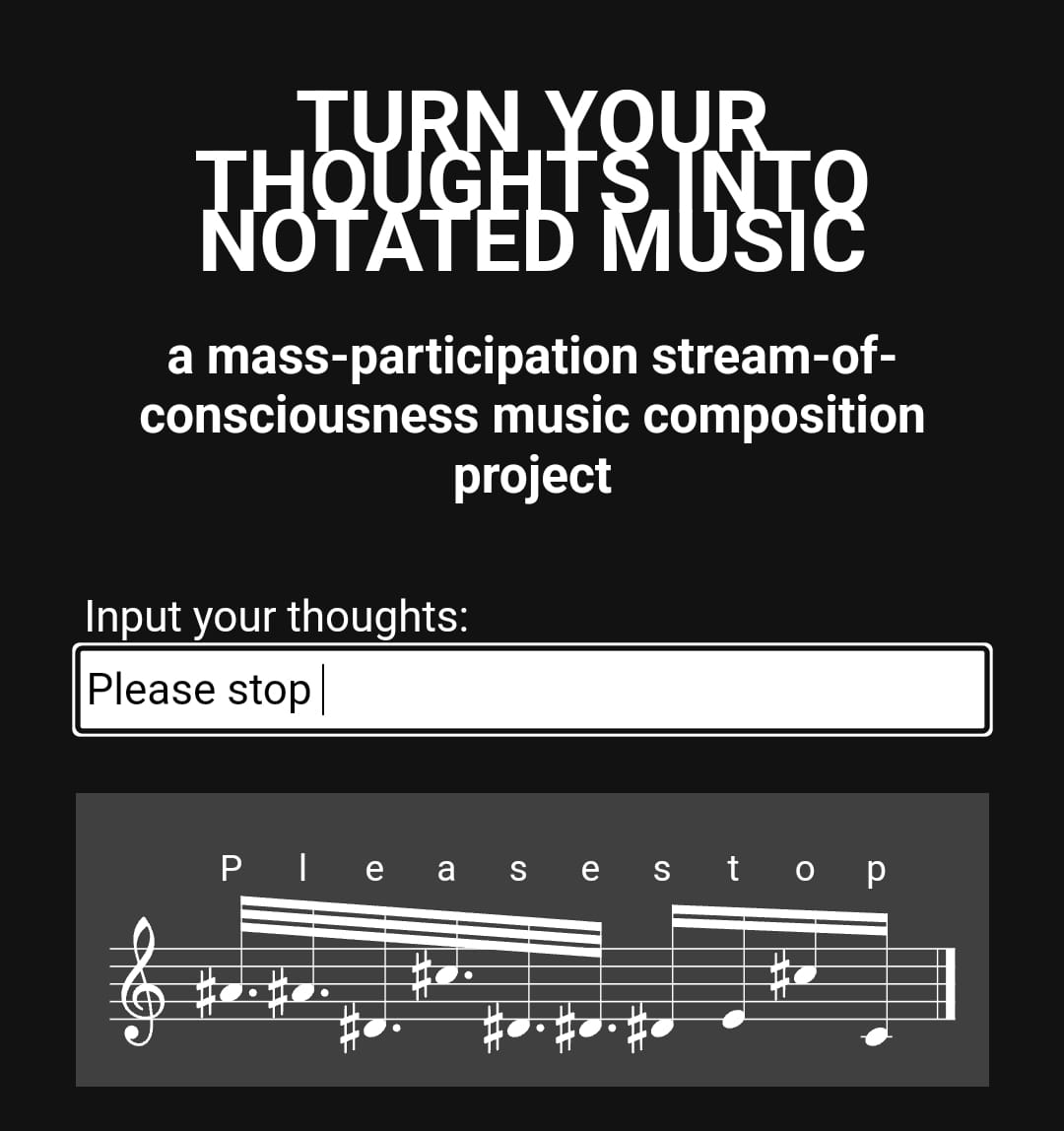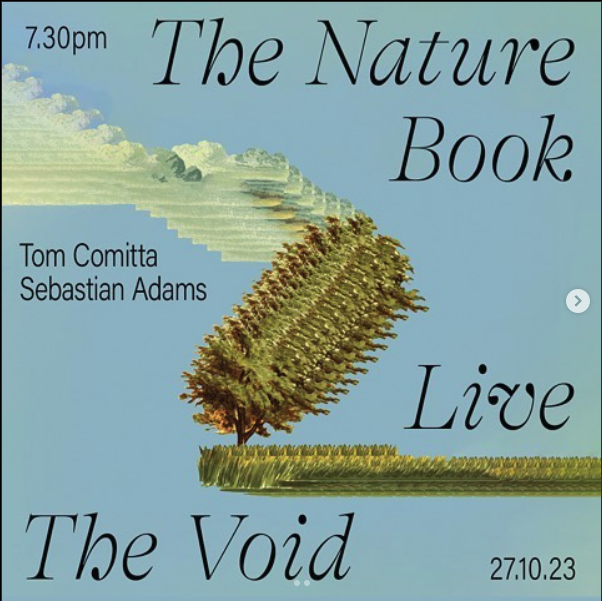Complete works
All materials are freely available, except where I don't own the necessary permissions. Provided as is, please report bugs or mistakes. Feel free to get in touch with questions or to let me know you're interested in my work!
Workings from Work for Harpsichord
(2014)
generative notation system, three performers
Workings from Work for Harpsichord
(2014)
Weight Piece
(2018)
event score
Weight Piece
(2018)Read Text Score
sunday morning, hawk cliff
(2011)
[5]
fixed media electronics
sunday morning, hawk cliff
(2011) [5]Programme Note:
Dankgesang II: Trump
(2019)
[7]
tape
Dankgesang II: Trump
(2019) [7]
CrowdScoreSing
(2013)
[8]
violin, cello, flute, horn, trumpet, percussion (glockenspiel, cow, piano, three actors
CrowdScoreSing
(2013) [8]
sunday morning hawk cliff
(2011)
[4]
fixed media stereo audio
sunday morning hawk cliff
(2011) [4]Hawk Cliff (also known as the Vico Baths) is probably the most beautiful and peaceful place to swim in Dublin (unless the water is too rough or there are jellyfish around..). I was given an assignment to combine field recordings with home-made synthesiser sounds, and decided to use the sea as a soundtrack. I decided to use my music to complement the soundtrack, rather than the other way around, so my contribution is quite minimal! Thanks to Mark Horgan, for moral support and judicious help with choosing a spot to record from. (Boring technical programme note below)
Nestled beneath Vico Road, where the rich and famous of Dublin lock themselves away from the public, Hawk Cliff is a place of splendid isolation. Men go there, not only to bathe, but to lose themselves to solitude, lulled into meditation by the lapping of the ocean.
To accompany the sound of Hawk Cliff without interrupting its natural rhythm meant stripping back my approach to composition virtually to nothing. There are five different synthesisers, all very simple. Each has three oscillators phased and tuned differently and, at most, a comb filter or ring modulator to add interest to the sound. The pitches used by each synthesiser expand outwards in a kind of Christmas tree formation, with each moving by a different interval. Essentially, each synthesiser builds a chord of a specific stacked interval. They each add pitches at different rates, albeit all too slowly for a discernable beat to come through. Each synthesiser begins its chord from a different note, working by a descending circle of fourths (C,G,D,A,E...). An external ring modulator working equally on all five synthesisers is the only further processing.
By applying a somewhat serial approach to the composition, I reduce the impression my own musical personality leaves on the piece. I thought this was the right way to create a work about somewhere where people go to leave their individuality behind. Rather than becoming lost in thought, the patrons of Hawk Cliff become temporarily lost from thought, and simply exist.
Underwater World
(2010)
[7]
fixed media electronics
Underwater World
(2010) [7]Programme Note:
Umbrella [collab. with Jools Gilson; early prototype]
(2019)
installation for electronic umbrella and audio [presented at CARPA6, Helsinki, Aug 2019]
Umbrella [collab. with Jools Gilson; early prototype]
(2019)
Duo with Jonathan Nangle
(2018)
viola, electronics
Duo with Jonathan Nangle
(2018)
Weird Viola Players (set with Joanna Mattrey and Cleek Schrey)
(2024)
three violas (improv, led by Cleek Schrey)
Weird Viola Players (set with Joanna Mattrey and Cleek Schrey)
(2024)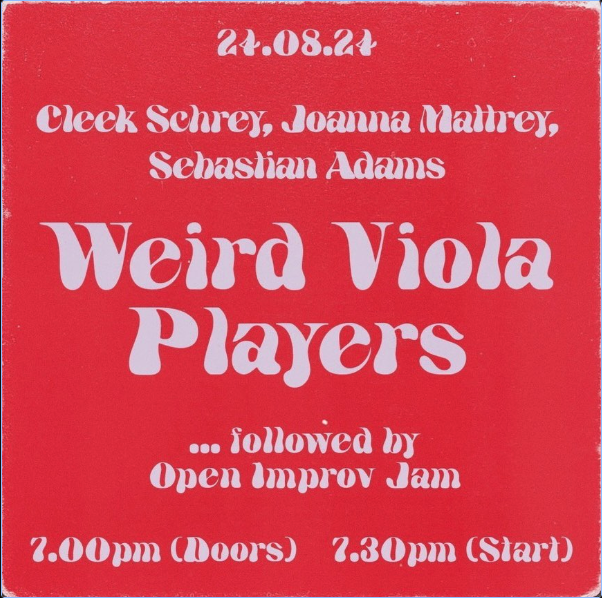
Three unique viola / string improvisers join forces since Cleek is in the country (this gig is a long time coming). After a set from the trio, audience members are welcome to join in an informal improv jam.
Performers: Cleek Schrey, Joanna Mattrey, Sebastian Adams
DATE: 24.08.24
TIME: Doors - 7.00pm / Start - 7.30pm
VENUE: Unit 44 (Kirkos)
TICKETS: FREE, donations welcome (and will go directly to the musicians) — No booking required
DURATION: c. 40 minutes (+ improv jam)
timetravel webradio
(2023)
web installation (playback of web radio)
timetravel webradio
(2023)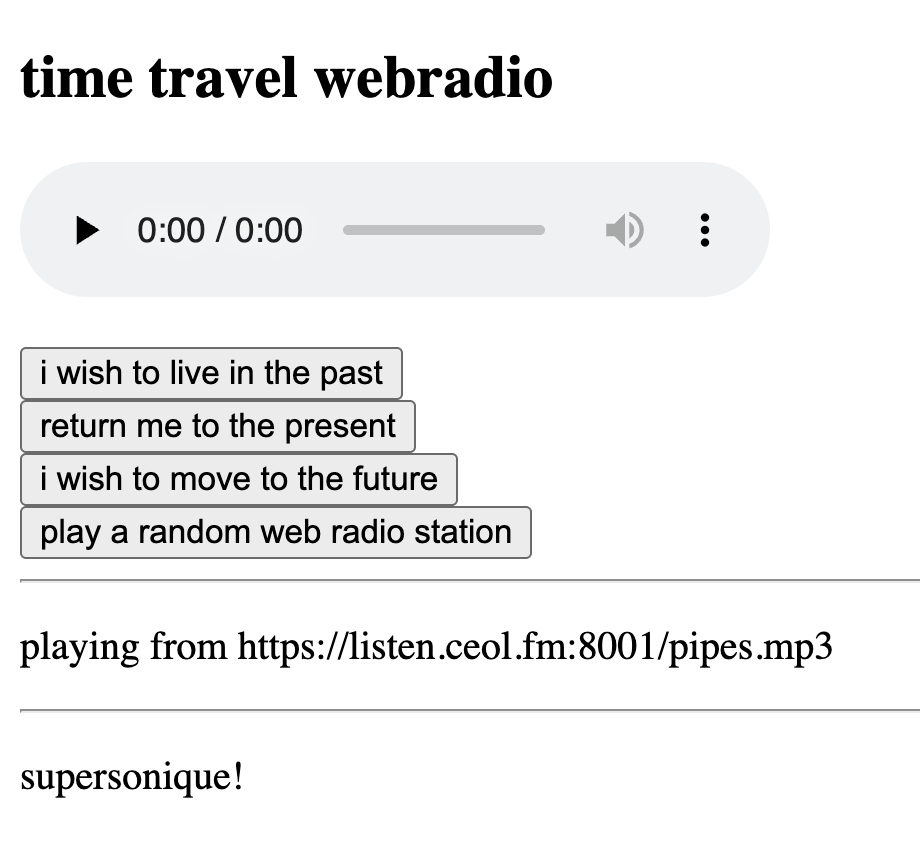
A huge selection of digital radio stations from Ireland and France are randomised, and you can go back in time (by playing them slower: the longer you listen to it like this, the further away you are from the real-time radio stream) or forwards in time: unlike a real radio station, digital radio often relies on file streams - so even when something hasn't happened yet you can often fast-forward through them.
Masturbate Piece
(2019)
event score
Masturbate Piece
(2019)Read Text Score
Freed Sounds Instrument
(2022)
audience with internet-connected mobile phones
Freed Sounds Instrument
(2022)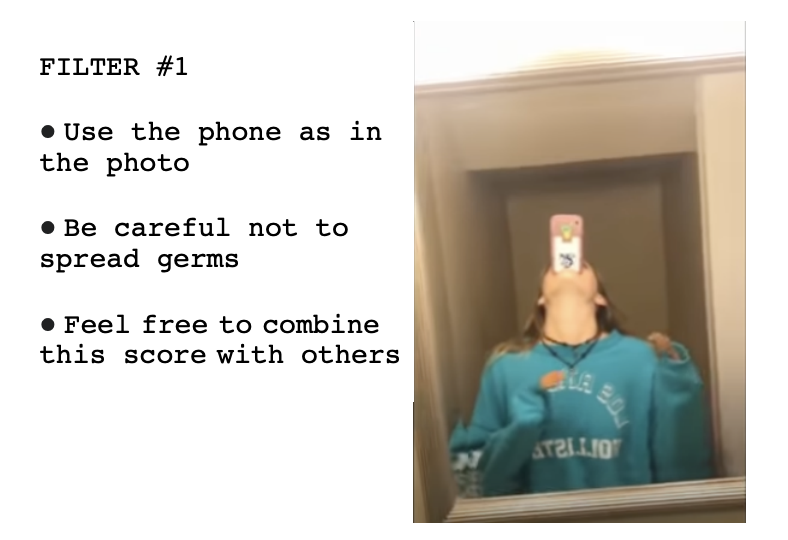
An instrument for playing with samples from freesound.org, with a set of accompanying text scores that can be used to process your performance of this. Suitable for performance in a group using mobile phones as loudspeakers.
Evinescence
(2011)
[6]
accordion, fixed media electronics
Evinescence
(2011) [6]
Thought Music
(2022)
interactive web page (for use by anybody): text input converted into music and can be played back and saved to a database
Thought Music
(2022)
Mirrors and Reflections
(2010)
[5]
viola, fixed media electronics
Mirrors and Reflections
(2010) [5]
Tense Systems (v. 1)
(2019)
[26]
performer, video, DIY-violin
Tense Systems (v. 1)
(2019) [26]
Max Receive Finder
(2024)
software to assist with finding all receives or subpatches in a Max patch
Max Receive Finder
(2024)Solves a problem I found no ready-made solution for:
Finds all instances of r, receive and receive~ objects in a Max patch. This can be very useful if you are trying to document your patch, particularly if you communicate with receives using messages to Max. Can also help to troubleshoot redundant receives and inconsistent naming patterns.
To use, simply upload your patch and receive a list of all the receives in the patch
Or, as it's basically the same code, find all subpatchers in a patch
This software is licensed with The Unlicense and can be used freely. Max patches will be processed on your local machine and not uploaded to any servers.
Near and Exact Repetition (collab. with Jonathan Nangle)
(2019)
installation for tape loops, tape players and modular synthesiser
Near and Exact Repetition (collab. with Jonathan Nangle)
(2019)
Stories from the Rain Box [collab. With Jools Gilson]
(2017)
[28]
radio documentary; sound art
Stories from the Rain Box [collab. With Jools Gilson]
(2017) [28]Programme Note:
Omegle Piece
(2019)
event score
Omegle Piece
(2019)Read Text Score
Fluxkit Transcriptions
(2024)
open instrumentation, including typist (premiere: flute, horn, keyboard, cello, typist)
Fluxkit Transcriptions
(2024)A typist transcribes texts contained in a Fluxkit into musical notation, which is displayed to performers (and audience). The music notation, along with the typed text, is then used as a framework for improvising by a group of performers.
To play this piece, you also need to get or make a Fluxkit. A Fluxkit is a collection of event scores stored in a container (e.g. Water Yam by George Brecht). I made the piece with the Fluxkits Kirkos created in 2016 in mind, and used one of these to play the premiere. If you don’t have access to a Fluxkit, you could make one, for example by cutting up parts of the Fluxus Workbook (freely available online e.g. on the Monoskop website) and placing them in a box.
The first performance of this piece was played by Lina Andonovska, Hannah Miller, Adam Collins and Yseult Cooper Stockdale (as Kirkos) on 25.06.24 as part of an Irish Composers’ Collective concert in Unit 44, Dublin. I was the typist for the performance.
The software used for this performance (ChatMusic) is currently only available by request. Please get in touch if you're interested.
2019.8
(2019)
string quartet; violin, violin, viola, cello
2019.8
(2019)Commissioned by National String Quartet Foundation
Tweet Piece (#1)
(2012)
4 - 8 performers
Tweet Piece (#1)
(2012)
tHaasX
(2023)
generative web browser music
tHaasX
(2023)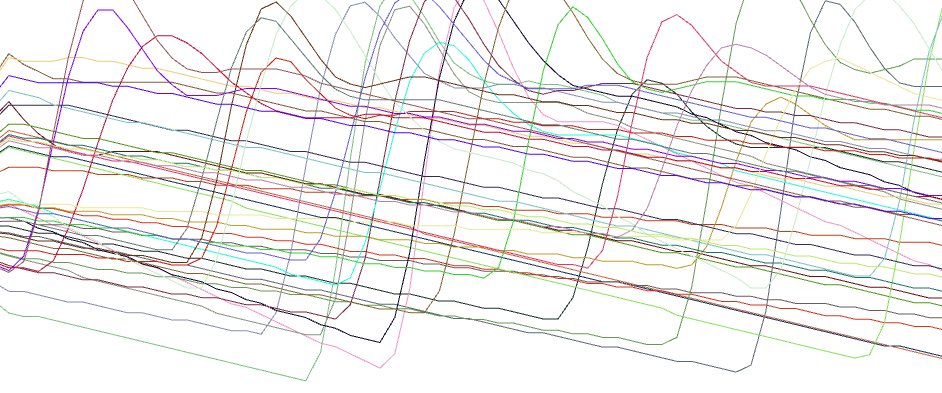
A generative implementation of the famous and amazing THX deep note, where random voices convene on a major chord. I added extra overtones to make it sound like a G.F. Haas piece. With a multi-dimensional oscilloscope to represent the sound in coloured lines. Unique each time you run it! Implemented using WebAudio (actually the first experiment I ever made with WebAudio, a couple of years ago), and animated using the built-in FFT analysis from WebAudio, coupled with HTML Canvas (just did this part yesterday). Because there are a huge number of oscillators + all the FFTs, it's quite heavy...so it sounds prettier on a computer. I'm sure it would be possible to make a much more efficient version but I was more interested in trying out the visualisation this week than optimising the audio code!
Try it a few times! You can also layer multiple renditions on top of one another, as long as the computer can handle it!
Spotify Record Collection
(2024)
web app
Spotify Record Collection
(2024)Not a piece, but a way to reproduce an old-fashioned record collection using Spotify.
I miss my old CD collection and also the alphabetical lists of albums/artists which helped me decide what I would like to listen to - rather than relying on the algorithm which seems to insist that Mitski is the same genre as every sad woman with a guitar
The record collection app lets you add albums to your collection. They are then added to a playlist on your Spotify account, but also displayed with the album art on the web app so you can see them all and remember what you might like to listen today.
I find it useful to help me remember what I used to listen to a long time ago, which is very difficult with anything algorithm-based.
The app works, but its not fast, and it's not pretty. Let me know if you're using it, I'd be really interested to hear what you think!
Turing Test: TypeWorks2 - 4
(2017)
generative notation system, performers
Turing Test: TypeWorks2 - 4
(2017)
Chat Music (collab. with Carl Ludwig Hübsch) [WIP]
(2022)
any instruments, Twitch stream, audience
Chat Music (collab. with Carl Ludwig Hübsch) [WIP]
(2022)
dancing_at_lughnasa_draft2_070725_153
(2025)
[2]
fixed media stereo audio
dancing_at_lughnasa_draft2_070725_153
(2025) [2]made at the request of Dan Callanan for Department of Energy's Ambient Harvest (Landscape Mixtape). Track 25 on the mixtape
Made from Bill Whelan's soundtrack from Dancing at Lughnasa using MuBu for audio-descriptor-based concatenative audio synthesis.
Tweet Piece (#2)
(2012)
[8]
guitar, fixed media electronics
Tweet Piece (#2)
(2012) [8]Programme Note:
Arrest Piece
(2016)
event score
Arrest Piece
(2016)Read Text Score
Portrait Piece
(2019)
event score
Portrait Piece
(2019)Read Text Score
Beethoven Freeze (Broken)
(2019)
[10]
installation for smashed violin with embedded fixed media electronics
Beethoven Freeze (Broken)
(2019) [10]
Breath play [WIP]
(2020)
viola
Breath play [WIP]
(2020)Read Text Score
The Nature Book performance with Tom Comitta (Unit 44)
(2023)
improvised electronics performance (radios, samples) combined with readings by Tom Comitta from The Nature Book (Unit 44)
The Nature Book performance with Tom Comitta (Unit 44)
(2023)
Turing Test No. 1
(2014)
generative notation system, performer
Turing Test No. 1
(2014)
Circum (after James Joyce)
(2022)
[8]
any instruments, performing from a projected animated score (originally: accordion, flute, percussion, soprano)
Circum (after James Joyce)
(2022) [8]
Circum is an experiment in creating a silent, animated score: the visual element is supposed to be visible both to the performers and the audience and it acts as the entire "text" for the performers. For the musicians, the video inspires them to create sound, generating a feedback loop where their actions are affected both by the video and the sonic choices they have already made. For the audience, however, sound and sight unfold simultaneously. Circum is also my first attempt as an Irish artist to get into the world of James Joyce - probably the most important Irish artist? My transitions, which sit between pieces focused on specific episodes of Ulysses, transverse the entire text (backwards) in several ways, treating Bloomsday like Groundhog Day. The animated score is made of text transformed algorithmically into music notation, both displayed using particle systems
Commissioned by Between Feathers
How to Build a VIOLIN in TWENTY MINUTES Tutorial
(2021)
[20]
open instrumentation, designed for audience performance
How to Build a VIOLIN in TWENTY MINUTES Tutorial
(2021) [20]Read Text Score
Tide Quartet
(2020)
[90]
string quartet; violin, violin, viola, cello
Tide Quartet
(2020) [90]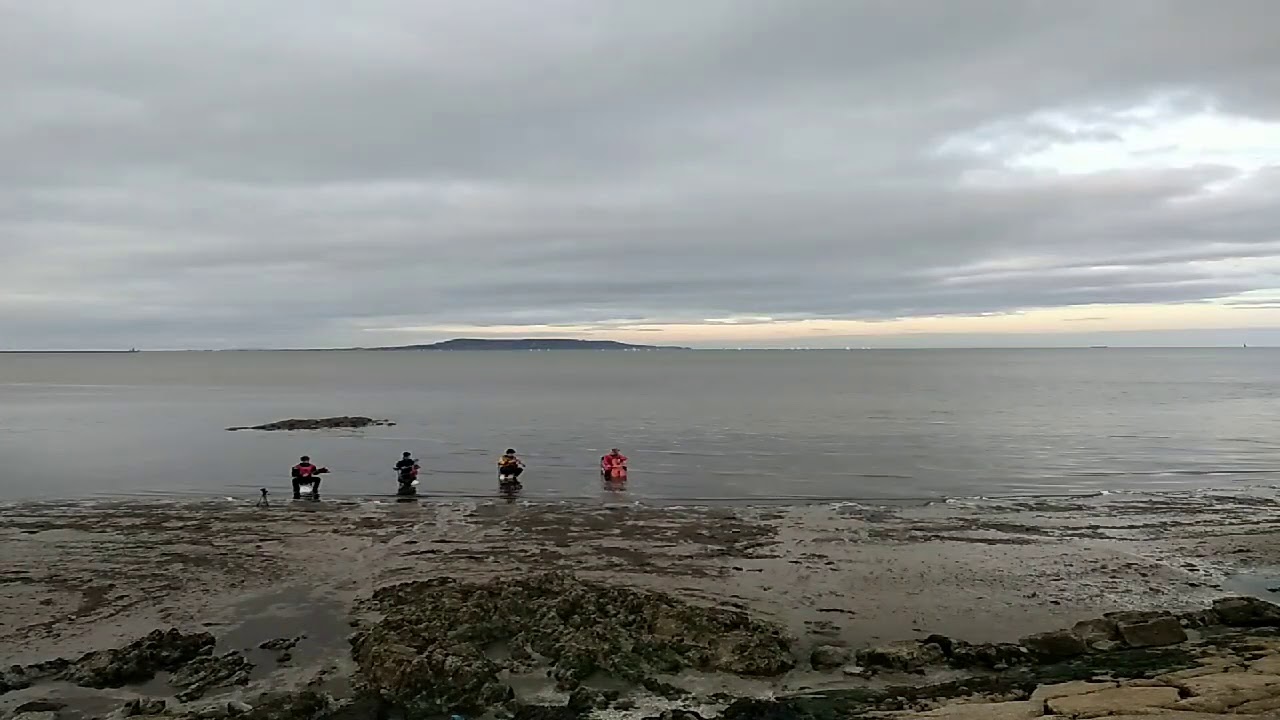
A string quartet dress in wet suits, sitting on chairs on the dry sea-bed in Dublin Bay. They perform a theme and variations (improvised from a set of instructions) as the tide begins to rush in around them. The performance ends for each musician only when the water reaches their neck, making it a durational piece reliant on the speed of the tide. Afterwards, the saturated instruments will be retrieved and the composer will attempt to save them by leaving them to dry naturally. This process will also be recorded and shown on this website. Unsalvageable parts will be repaired using driftwood, and the piece will be performed again next year.
Dankgesang I
(2019)
[9]
any instrument(s), tape
Dankgesang I
(2019) [9]
stolenmusic.org
(2023)
web portal (ongoing)
stolenmusic.org
(2023)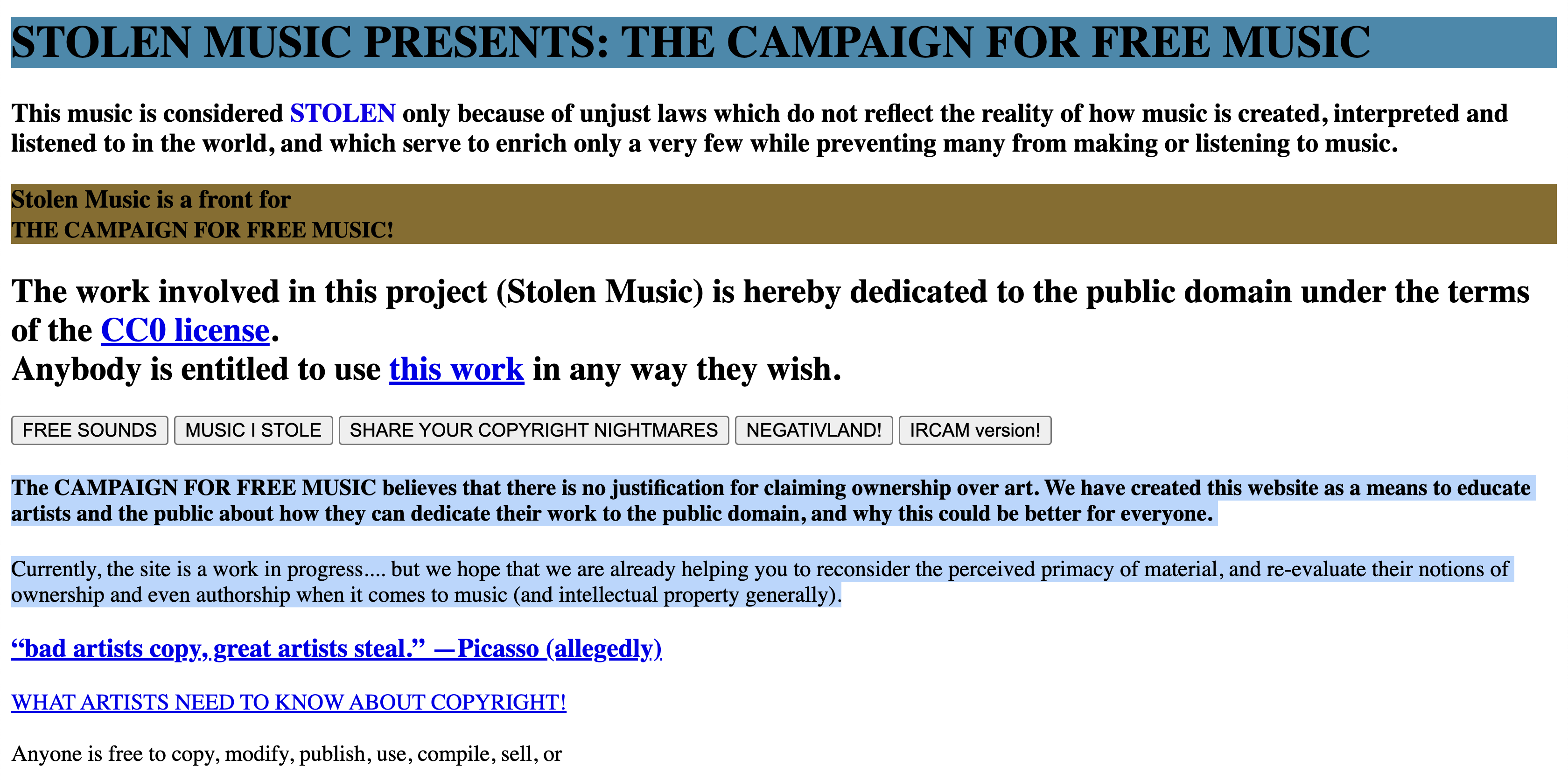
The CAMPAIGN FOR FREE MUSIC believes that there is no justification for claiming ownership over art. We have created this website as a means to educate artists and the public about how they can dedicate their work to the public domain, and why this could be better for everyone.
Currently, the site is a work in progress.... but we hope that we are already helping you to reconsider the perceived primacy of material, and re-evaluate their notions of ownership and even authorship when it comes to music (and intellectual property generally).
2019.1
(2019)
double bass, transducer, optional electronic processing
2019.1
(2019)Programme Note:
Lightbulb [audio only, visuals by Mary Leonard]
(2012)
[4]
fixed media electronics and video
Lightbulb [audio only, visuals by Mary Leonard]
(2012) [4]
I STILL haven't found what I'm looking for
(2023)
[8]
8 channel fixed media audio (or binaural mixdown)
I STILL haven't found what I'm looking for
(2023) [8]Using MuBu, I chopped up I Still Haven't Found What I'm Looking For into a dense collage of tiny fragments which I improvised with in Max/Spat/MuBu and then pieced together in Reaper.
I made this for the Chaire Supersonique project i did in collaboration with IRCAM and the Beaux-Arts de Paris.
Big nod to Negativland here!
Viola Transcription of 'Failing: a Very Difficult Piece for Solo String Bass' by Tom Johnson
(2021)
[10]
Viola Transcription of 'Failing: a Very Difficult Piece for Solo String Bass' by Tom Johnson
(2021) [10]Read Text Score
trombone, transducer, tam-tam
(2021)
[5]
trombone, percussion (1 player; tam tam, hand-held transducer with small amplifier)
trombone, transducer, tam-tam
(2021) [5]
Stolen Music
(2022)
[10]
fixed-media multi-channel video, diffused stereo sound, printed text materials, audience members with kazoos, interactive website and live narration
Stolen Music
(2022) [10]Stolen Music was originally conceived for my final project as part of the IRCAM Cursus, but it is also an ongoing musical world-building project composed of websites, audio collages, acts of piracy etc.
The basic aim of the project is to explore two main ideas that matter to me:
Examining the boundaries of a "piece" of music: questioning the idea of the sole author and finding ways to subvert the linear, sectional timeline of a typical musical performance
Presenting an argument that all musical material should be fair game for all people to work with, regardless of who owns it under current copyright law.
This project owes a huge debt to Claudia Jane Scroccaro, the other teachers at IRCAM, and my colleagues from my course who let me mess with their music. Much more info is available on the dedicated website.
Small adjustments that over the years forged a new landscape [collab. Joan Somers Donnelly]
(2019)
[120]
performance installation; viola/performer/electronics/vegetation/casette players/
Small adjustments that over the years forged a new landscape [collab. Joan Somers Donnelly]
(2019) [120]
2019.6
(2019)
[7]
horn, electronics
2019.6
(2019) [7]Programme Note:
One
(2013)
[20]
viola, live electronics
One
(2013) [20]
Beethoven Freeze
(2018)
[120]
installation for string instruments with transducers
Beethoven Freeze
(2018) [120]
Quartet for viola and three radios
live viola, three radios, three transmitters, multi-channel playback and a microphone
Quartet for viola and three radios
Read Text Score
Three radios are set up at the very beginning of the piece but playing only silence. Each is tuned to a different radio station. The radios are set up in a line with a space between them, with the viola player standing in the fourth position in the line.
The three radio stations correspond to the frequencies of three low-powered radio transmitters placed in the venue. Each is connected to a channel of the multi-channel playback device.
A microphone is unobtrusively placed in the space and begins recording when the viola player starts playing.
After a certain amount of time, the first radio starts playing back the recording.
After two more periods of time, the remaining radios also join in, so a canon accumulates.
So far, I've only performed this once and the performance officially "failed" - because I forgot to sit beside the microphone, meaning it only picked up a very, very quiet signal. Once I realised, I was forced to play very quietly to compete with it (which then made the later parts of the canon even more quiet), The YouTube clip here is from that performance - it was somehow a nice effect even though my idea didn't work at all
I think the piece has legs though!
ghost box
(2023)
generative website installation (with web radio)
ghost box
(2023)Inspired by an idea of Anaïs Fontanges, this is a web page that emulates ghost-hunting radio scanners as used by paranormal investigators. This idea sparked a period of fanatacism about radio and particularly about how the weird romance of the ephemerality radio somehow holds on even when you carry it into the digital domain (where the ephemerality is a little bit faked...)
It basically cycles randomly through a range of French and Irish web radio stations, with white noise faking a transition between stations! But sure the REAL ghost boxes are fakes too, aren't they....>>??????
espresso - micro sonata
(2021)
[2]
for performance by anybody (earphones and espresso required)
espresso - micro sonata
(2021) [2]Read Text Score
Turing Test: TypeWork1
(2016)
generative notation system, performers
Turing Test: TypeWork1
(2016)Programme Note:
Deciphering
(2018)
generative notation system, seven performers
Deciphering
(2018)
500 Minutes of Music for Microtonal Piano
(2022)
[500]
piano or MIDI piano
500 Minutes of Music for Microtonal Piano
(2022) [500]
Excerpts from Reality
(2025)
[-]
video score for open instrumentation (premiere: flute, clarinet, violin, cello, electric guitar)
Excerpts from Reality
(2025) [-]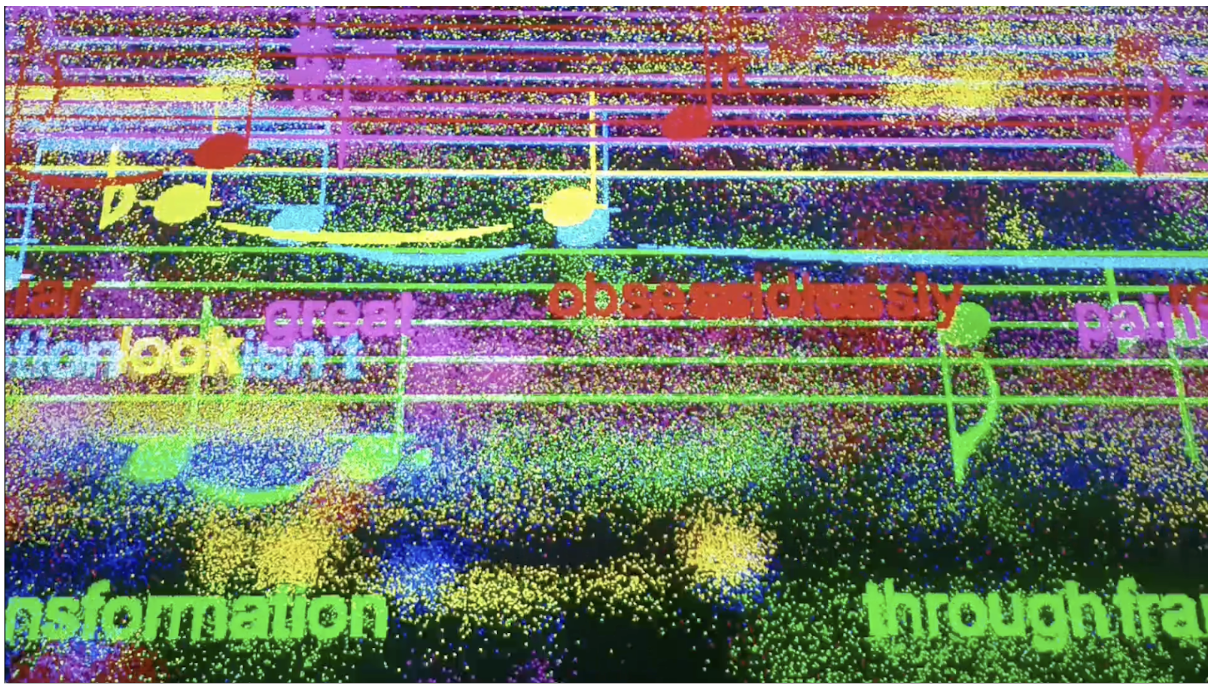
Excerpts from Reality was written for a Crash Ensemble performance held in UCD, and draws on text from Reality Hunger, a text which is itself made from found text (hence the piece ties in to Stolen Music). In my piece, text drawn from the book is depicted on a video screen as clouds of particles arranged into the text which dissolve gradually and rearrange as music notation (which is algorithmically derived from the text). The video screen serves as a score for the performers, who are expected to interpret the overall visual and semiotic impression (notation, text, colours, movement) and use it as a source for improvisation. As the score is also improvised (by the composer, using an interface which allows selection of specific passages of text as well as control of various visual parameters and the algorithm used for translating into notation), a complex feedback loop between composer, performers and video arises: agency becomes distributed across the performers and composer in a way which is difficult to unravel. As such, it is an attempt to place the composer in the midst of performers as a fellow improviser.
Quartet for viola and three radios
live viola, three radios, three transmitters, multi-channel playback and a microphone
Quartet for viola and three radios
Read Text Score
Three radios are set up at the very beginning of the piece but playing only silence. Each is tuned to a different radio station. The radios are set up in a line with a space between them, with the viola player standing in the fourth position in the line.
The three radio stations correspond to the frequencies of three low-powered radio transmitters placed in the venue. Each is connected to a channel of the multi-channel playback device.
A microphone is unobtrusively placed in the space and begins recording when the viola player starts playing.
After a certain amount of time, the first radio starts playing back the recording.
After two more periods of time, the remaining radios also join in, so a canon accumulates.
So far, I've only performed this once and the performance officially "failed" - because I forgot to sit beside the microphone, meaning it only picked up a very, very quiet signal. Once I realised, I was forced to play very quietly to compete with it (which then made the later parts of the canon even more quiet), The YouTube clip here is from that performance - it was somehow a nice effect even though my idea didn't work at all
I think the piece has legs though!
